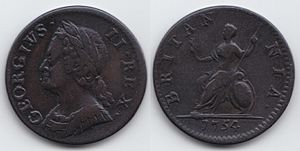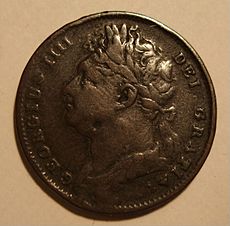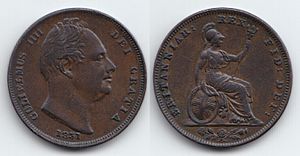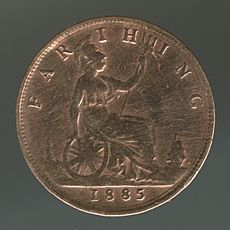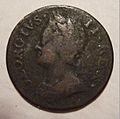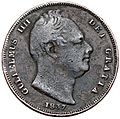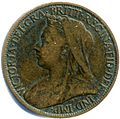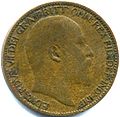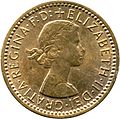History of the British farthing facts for kids
The British farthing was a small coin from Britain. Its name comes from an old English word, feorthing, which means "a fourth part." This coin was worth a quarter of an old penny. To give you an idea, it was 1/960th of a pound sterling. The Royal Mint stopped making farthings after 1956. They were officially taken out of circulation on January 1, 1961.
The British farthing continued a tradition of English farthings. These coins were made by English kings and queens before the Act of Union 1707. This act joined the kingdoms of England and Scotland to form Great Britain. Under Queen Anne, only special sample farthings were made. This was because there were already many farthings from earlier reigns.
Farthings were made sometimes during the reigns of George I and George II. But by the time George III was king, too many fake farthings were being made. So, the Royal Mint stopped making copper coins after 1775.
The next farthings were special. They were the first coins made using steam power! This happened in 1799. Matthew Boulton made them at his Soho Mint with a special permit. Boulton made more in 1806. The Royal Mint then started making them again in 1821. The farthing was made quite often under George IV and William IV. These coins usually looked like smaller versions of the penny. They continued to look similar to the penny and halfpenny until after 1936.
Farthings were made in most years during Queen Victoria's long reign. The coin continued to be made for much of the first half of the 20th century. In 1937, it finally got its own unique design on the back: a wren bird. By the time the coin showed the portrait of Elizabeth II from 1953 to 1956, its value had become very small due to inflation. People also stopped needing them as much, which led to their end.
Contents
Early Farthing Coins (1714–1775)
The British farthing continued a series of farthings that began in the 13th century. These earlier coins were made of silver under the English king Henry III. In the 1500s, private people made copper farthing tokens for small change. In 1613, King James I gave John Harington, 1st Baron Harington of Exton, a special right to make royal farthing tokens. These tokens were copper and had the king's name on them.
In 1672, King Charles II allowed the mint to make the first official copper farthing coins. This was when Britannia first appeared on the coin.
During most of Queen Anne's reign (1701–1714), new farthings were not needed. There were already many English farthings in circulation. But by 1713, there was a shortage of copper coins, including halfpennies and farthings. The Royal Mint planned to make farthings in 1714. However, Queen Anne died that year, stopping the plan.
The 1714 farthing, weighing about 4.8–5.8 grams, is considered a pattern coin. It was about 21–22 millimeters wide. It contained almost a farthing's worth of copper. This was because Sir Isaac Newton was in charge of the Mint. He believed coins should be worth their metal. Some Anne farthings did get into circulation. There was a popular but untrue story that they were worth a huge amount of money.
The image of Britannia on the coin is said to look like Queen Anne. This was when the idea of Britannia as a symbol of Britain, mixed with the image of the queen, became strong. Newton cared a lot about coin quality. The Anne farthing showed improvements, like more consistent making, compared to coins from William III's time.
The need for copper coins continued after King George I (1714–1727) became king. But the Anne halfpennies and farthings had failed purity tests. It wasn't until 1717 that Newton tried to make these coins again. This time, he used copper bought from a supplier. The price of metal had gone up. So, the new farthings were lighter than the Anne coins, weighing 4.5–5.3 grams.
The farthings made in 1717 were smaller and thicker. They were 20–21 millimeters wide and are called "dump" farthings. Farthings from 1719–1724 were a bit larger, 22–23 millimeters, but weighed the same. The designs on these coins were very raised. The Royal Mint had trouble pressing the design onto the blank coins. This led to many small mistakes.
The coin showed King George's head facing right. It had the words GEORGIVS REX. The back looked like the Anne farthings. It showed Britannia with the word BRITANNIA and the date below. Farthings were sold at the Mint in the Tower of London. They came in packs worth five and ten shillings. The government did not provide money to send them to other parts of the country.
The designs for these farthings were made by John Croker. They were made every year from 1717 to 1724. The Mint had a seven-year contract for the copper. When the contract ended, coin making stopped.
King George I died in 1727. His son, King George II, became king and reigned until 1760. Croker also designed the new king's head for the coins. The Britannia design stayed the same. Farthings with Croker's design were made from 1730–1737 and in 1739. A design showing an older king by John Sigismund Tanner was used on the farthing in 1741, 1744, 1746, 1749, 1750, and 1754. The 1754 coins were likely made until at least 1763.
All George II farthings weighed 4.5–5.3 grams. They were 22–23 millimeters wide. Both sides showed King George's head facing left. They had the words GEORGIVS II REX. The back showed Britannia with BRITANNIA and the date. Farthings were made in smaller numbers than halfpennies. Halfpennies were made every year from 1730–1754.
Coin making stopped in 1754 because there were too many copper coins. Merchants asked for this stop. But a new problem had appeared: fake coins. Lightweight fake halfpennies and farthings (pennies were silver then) were seen as early as 1725. In the next few decades, they became very common. At that time, making fake copper coins was only a minor crime. It meant a fine or a short time in jail. But making fake gold and silver coins was punished very harshly.
Fake coins were especially common in the countryside. This was because official coins, without a good distribution plan, were rarely seen there. No farthings were made after 1754. The Royal Mint suggested making the farthing worth 1/6th of a penny in 1755. They also suggested making the halfpenny worth 1/3rd of a penny. This was to make counterfeiting unprofitable. But the government said no.
The first halfpennies and farthings with the head of King George III were made in 1771. This was the year Parliament made it a serious crime to fake copper coins. But this did not help much. Many real coins were melted down to make lighter fakes. However, the farthing was faked less often than the halfpenny. This first series of George III farthings was made in 1771 and from 1773–1775. They weighed 4.3–5.3 grams and were 23–24 millimeters wide.
The front of the coin, designed by Richard Yeo or Thomas Pingo, showed the king's head facing right. It had the words GEORGIVS III REX. The back design did not change much. Despite the fakes, the Mint stopped making copper coins in 1775. They said there were enough legal farthings and halfpennies in use. The Royal Mint would not make farthings again until 1821.
New Farthings from Soho and the Royal Mint (1799–1837)
After 1775, most copper coins in circulation were fake. Private companies started making their own tokens in 1787 to fill the gap. The government then gave Matthew Boulton a contract to make copper coins in 1797. At his Soho Mint near Birmingham, Boulton made the famous "Cartwheel" pennies and twopences. These were the first official British coins made using steam power.
Boulton's contract did not include farthings at first. But he did make several sample farthings. In 1799, Boulton got permission to make halfpennies and farthings. By then, the price of copper had gone up. So, a more normal-looking coin was made.
The 1799 farthing was special in two ways. First, the back of the coin said 1 FARTHING. This was the first time a coin's value was written on an English or British coin. Second, it was the first British coin to have the date on the same side as the king's head. The front of the coin said GEORGIUS III DEI GRATIA REX. The back showed a new design of Britannia sitting. She held a plant and a spear. The words were BRITANNIA 1 FARTHING.
In 1806–1807, Boulton made another 22.5 tons of copper into farthings. But the price of copper had risen again. So, these coins weighed less than the 1799 ones. The 1799 farthings weighed 5.8–6.6 grams and were 23–24 millimeters wide. The later Boulton farthings weighed 4.7–4.8 grams and were 21–22 millimeters wide. For the 1806–1807 coins, the value (1 FARTHING) was removed. The words DEI GRATIA were shortened to D G. Britannia's image was also changed a little. Old copper farthings and halfpennies from before 1797 were officially called back in 1817. They were bought back by their weight.
The money system was updated in the 1810s with the Great Recoinage of 1816. Copper coin production did not start again until after George III died in 1820. Then King George IV (1820–1830) became king. Farthings were made in 1821, with Britannia still on the back. These coins became official money in November 1821. They could be used for payments up to sixpence.
The first design of King George IV's head, by Benedetto Pistrucci, was not liked by the king. But it was used on the farthing in 1821 and from 1823–26. By then, Pistrucci was not allowed to work on coins because he refused to copy another artist's work. William Wyon was given the job of designing a more pleasing "bare head" type in 1826. Copper coins were made in 1826 because separate coins for Ireland were being stopped. The Irish penny was worth a bit less than the British one.
The back of the coin was slightly redesigned but stayed mostly the same. Pistrucci's farthings weighed 4.5–4.8 grams and were 22 millimeters wide. Wyon's later ones (made every year from 1826–1830) weighed 4.6–4.9 grams and were 22 millimeters wide. Both Pistrucci's and Wyon's designs were made in 1826.
Pistrucci's front design showed King George IV's head facing left. It had the words GEORGIUS IIII DEI GRATIA. The back showed Britannia, wearing a helmet, sitting on the left. She held a shield and a trident. The words were BRITANNIAR REX FID DEF with the date below Britannia. Wyon's front design showed King George IV's head with a wreath, facing left. The words on the back were the same.
When King George died in 1830, his brother, King William IV (1830–1837), became king. Wyon, who was now the Chief Engraver, kept the back of the farthing the same. For the front, he designed King William's portrait based on a work by Sir Francis Chantrey. The words were the same, except GULIELMUS IIII (William IV) replaced GEORGIUS IV on the front. The farthing was made in 1831 and from 1834–1837. The last ones were made in the year King William died.
Victorian Farthings
Farthings with the portrait of Queen Victoria, designed by Wyon, started being made in 1838. The back of the coin stayed the same. Only the word REG (Regina, meaning Queen) replaced REX (King) to show there was now a queen. The farthing stayed the same size as it had been since 1826.
From 1838, the farthing was made every year of Victoria's long reign except for 1870, 1871, and 1889. (The 1877 coins were only special proof versions and might have been made later.) The same front designs were used for the copper farthing and the sovereign (a gold coin). They were probably used for the gold coin first. This led to many small flaws in the farthing series. But it also meant they were made every year, just like the popular gold coin.
In Victorian times, a farthing could buy three oysters with bread and butter from a street seller in London. It was also enough to buy a sparrow at a market in London's East End.
In 1859, the government decided that the copper coins were in bad shape and needed to be replaced. The farthing especially needed new coins. A survey in 1857 found that farthings made up only about 3% of the copper coins in circulation. This was even though about 20% of the copper coins made since 1821 had been farthings. Bronze was chosen as a good replacement metal.
Parliament passed a law in 1860. This law allowed the penny, halfpenny, and farthing to be made from a bronze alloy. Many bronze pennies, halfpennies, and farthings were made starting in 1860. They were made by the Royal Mint and two companies in Birmingham. The penny's weight was cut in half. The farthing was made a bit lighter, but not as much, so it wouldn't be too small. The farthing looked almost the same as the penny and halfpenny, with only small differences. The new bronze coins started being used in December 1860. The old copper coins were taken out of circulation after December 31, 1869, in Britain. They were taken out of circulation in the colonies at the end of 1877.
The new bronze farthings weighed 2.8–3.0 grams. They were 20 millimeters wide. They were made of 95% copper, 4% tin, and 1% zinc. These measurements stayed the same until the farthing was stopped after 1956. The back of the coin said FARTHING. The date was below Britannia. The front showed Victoria's "Bun head" or "Young head" portrait. Both sides of the coin were designed by Leonard Charles Wyon, William's son. The words on the front were VICTORIA D G BRITT REG F D.
Some farthings from 1874–1876 and 1881–1882 have an "H" mark below the date. These were made at the Heaton Mint in Birmingham. The "Bun" farthing series had some varieties, but not as many as the penny and halfpenny. The farthing usually had the lowest number of coins made among the three bronze coins. Between 1 and 6 million were made in most years in the late Victorian era. More halfpennies were made than farthings. Penny production regularly went over 10 million by the 1890s. Even though fewer farthings were made, a larger number of them have survived. This is because British people felt a special connection to the coin with the lowest value.
In 1896, a new design for Victoria's portrait was put on the bronze coins. It showed Victoria as an older woman. This front design was by Thomas Brock and engraved by George William de Saulles. The farthing continued to use this design until the Queen died in 1901. De Saulles also updated the back design. The biggest change was removing the lighthouse and ship next to Britannia. They never returned to the farthing. The words on the "Old Head" farthing were VICTORIA DEI GRA BRITT REGINA FID DEF IND IMP.
Starting in 1897, farthings were made to look artificially darker. This was to avoid confusing bright new farthings with the half sovereign (a gold coin). The bronze farthing and the gold coin were the same size.
Twentieth Century and the End of the Farthing (1902–1956)
The farthing of King Edward VII (1901–1910), Victoria's son, was made every year from 1902 to 1910. It was still made to look artificially darker. The number of farthings made each year ranged from 2.6 million (1910) to 8.9 million (1908). At the same time, the number of pennies made never dropped below 12 million and went up to 47 million in 1907.
The designs on the penny, halfpenny, and farthing were almost the same. De Saulles used a special machine to shrink the designs for the smaller coins. The new front design was his work. It showed the king's head facing right. The words were EDWARDVS VII DEI GRA BRITT OMN REX FID DEF IND IMP.
The farthings of Edward's son, King George V, had a new portrait facing left by Sir Bertram Mackennal. The Britannia design continued on the back. Farthings with King George's portrait were made every year of his reign except 1910. The only change to the words was replacing EDWARDVS VII with GEORGIVS V. In 1917, the Mint stopped darkening farthings. This was because the half sovereign gold coin was no longer being made. Like the penny and halfpenny, the King's head was made a bit smaller in 1926. Britannia's image was also slightly changed that year.
The Edward VIII farthing is a sample coin. It was waiting for the king's approval when he gave up the throne in December 1936. There was a desire for more modern coin designs. The Irish Free State had started using coins with animal designs in 1927. Some colonies had also redesigned their coins. King Edward was also interested in moving away from the traditional symbols on British coins. He showed foreign coins to the Deputy Master of the Mint, Robert Johnson, and asked for similar ones.
King Edward eventually agreed to keep some traditional designs. He worried that new designs would not be popular with the British people. But non-traditional themes for the halfpenny (a sailing ship) and farthing (a wren) remained. The chosen design for the farthing was a wren. This put the smallest British bird on the smallest British coin.

The wren design was approved for the coins of Edward's brother, King George VI (1936–1952). It stayed on the coin for its last twenty years. Humphrey Paget redesigned the front to include the new king's head facing left. The words were changed to include GEORGIVS VI. The coin was made every year from 1937. In 1949, after India became independent, IND IMP was removed from the front.
When Queen Elizabeth II became queen in 1952, a new portrait appeared on the farthing the next year. It was designed by Mary Gillick. The words on the front were ELIZABETH II DEI GRA BRITT OMN REGINA F D in 1953. After that, they were ELIZABETH II DEI GRATIA REGINA F D. This change showed that some countries in the British Commonwealth were now republics.
After the Second World War, the farthing was used more often. The price of a one-pound loaf of bread was set by the government. This price often included an odd halfpenny. So, buying a half-pound loaf sometimes required a farthing for exact change.
By the 1950s, inflation meant the farthing could buy very little. People also stopped needing it for shopping. Letters to The Times newspaper showed this. One person wrote that a bus conductor refused to take eight farthings for a twopenny fare. Another said a seller became angry when offered six farthings for a newspaper. This happened even though the coin was still official money up to a shilling.
Demand for the farthing continued to drop. So, the Royal Mint stopped making farthings after 1956. Getting rid of the farthing also made it possible for officials to think about making smaller pennies and halfpennies. The farthing officially stopped being legal money after December 31, 1960.
Obverse Designs
See also
- Coins of the pound sterling
- Penny-farthing (bicycle)




